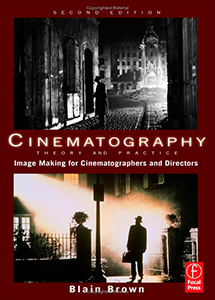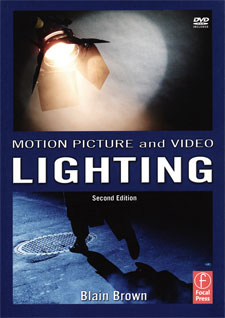
Review by Rick Gerard
Gerard Production
© 2003 Rick Gerard and CreativeCOW.net.
Blain Brown has created a masterpiece. Cinematography: Image Making for Cinematographers, Directors, and Videographers is his third book and for the aspiring or experienced cinematographer – the best reference book I have ever seen.
Anyone that aspires to this highest art of story telling should have this book on their shelf. He writes "At the heart of it, filmmaking is shooting, but cinematography is more than the mere act of photography. It is the process of taking ideas, words, actions, emotional subtext, tone and all other forms of non-verbal communication and rendering them in visual terms." Through both verbal metaphor and pictorial example he takes the keys to this art from their hiding place under the bed and hangs them right there on the peg on the kitchen wall. All you have to do is take them down and apply them.
Learning the language of visual art is more than just learning the difference between subjective and objective camera angles, or knowing what the director means when he says he wants “a choker.” When you have finished the first chapter you will have a good enough handle on the terms a director and cinematographer bandy about on the set to sound like a pro. By the time you get to the fifth chapter “Cinematic Continuity” you will have been exposed to enough graduate level theory and practice to start you on the road to mastery of the form. I especially enjoyed Blain’s explanation and examples of continuity in chapter five.
The next section of the book moves through every technical aspect of filmmaking from Exposure to Set Operations and Formats without ever forgetting to explain and theorize on the relationship between technique and story.
Frames from films directed by Orson Welles, Stanley Kubrick and Akira Kurosawa are used and analyzed not as a model for their style of filmmaking but as examples of controlling every part of the frame to achieve an effect. As Mr. Brown says: “not only do they serve as excellent examples of framing, composition, use of lens, blocking and color, but more importantly you know that nothing in the frame is an accident – it is easier to follow the choices that they made in order to serve the story."
This is a “must have” book for anyone claiming to be a cinematographer that hasn’t got at least two Academy Awards sitting on their mantle. Well done Mister Brown. Well done.
http://www.creativecow.net/index.php?forumid=120

Motion Picture and Video Lighting: A Review
This text is crammed with great details and technical tricks. There’s also a brief history of lighting and a section on how light shapes humans’ visual perception. Motion Picture and Video Lighting
------------------------------------------------------------------------
From the opening pages, I knew I was going to love this book. It is gourmet reading for the lighting connoisseur — a feast for those of us who love chiaroscuro, lightness, and dark. Author Blain Brown goes to great lengths to make this book as much about video as about film. Whenever he discusses a film technique, he makes sure to cover how it should apply to video as well.
While heavily technical in certain aspects, this 214-page text is crammed with great information, technical tricks, and data. You can devour, skim over, or skip them altogether. (Although it never hurts, even if you are a video purist, to learn about film.)
The chapters on lighting theory and practical applications really apply to each discipline. There's a brief history of lighting, which I found fascinating, followed by a detailed account of how the eye sees and the brain interprets images. But Brown goes beyond other books with a distinctive section on how light shapes our visual perception, and how we interpret the shape of our physical world by how light and shadows fall upon it.
Make no mistake — this is a textbook, but an easy-to-digest one. The book is complete with chapters on electricity, lamps and sockets, and even basic gripology. There are plenty of photographs, graphs, diagrams, and data tables for handy reference.
While the photographs in this book are the best of any of the books reviewed here, they still didn't quite get the job done. For instance, there is a series of color plates showing the subtle differences of diffusion materials such as tough frost and Hampshire, but it's hard to see much of a difference in the pictures. However, don't let this dissuade you from adding this excellent book to your library.
This book has has reached faculty at key film schools: UCLA, USC, NYU, NCARTS,
San Francisco State, University of Texas- Austin, and Columbia (Chicago).
Judy Irola at USC loves the text and has distributed copies
to her stable of cinematography instructors. She anticipates that the rush
of adoptions for this book will be in the fall since professors have to
decide on their books very early there.
Linda Brown who teaches at USC and the UCLA extension school
is very excited about the book. She recommended it to her current
cinematography students and is looking to use it in the spring for her
intermediate cinematography class.
Jaqueline Frost at Cal State-Fullerton is using the book in
her upper-level cinematography class.
Chris Bowen, an adjunct at Boston University (who works for
Avid), immediately decided on dropping Malkiewicz after just a brief look at
the book.
Judy Irola, University of Southern California, Cinematography Department
Head (makes suggestions to her 20-30 cinematography instructors): I gave the
Brown book to the directing teachers who handle the advanced classes. One
of them has already ordered the book for her class. I know the others will
follow suit. I also gave copies to intermediate camera and even a teacher
who teaches the first year. Everyone is reading the book. I know the
requistions for next semester went in last month so I don't know if big
classes will happen before fall but the smaller ones, the advanced classes,
can still happen... I think our first year classes will use the Wheeler
books in the fall. We (I teach at that level as well) can use the beginning
of next semester to thoroughly read them and then order. I send you many
thanks for the books. There was a line at my door of instructors who wanted
to read them. [Elinor did a lot of the legwork on this one. She put me in
touch with Judy when we were in L.A. back in October. -mjf]
Roger Carter, Community College of Aurora, enrollment 25: They were using a
couple other books for this class (I believe a directing book and The Visual
Story). Roger told me this book was exactly what his students need.
Linda Brown, University of Calfornia, Graduate Cinematography, enrollment
15: It is terrific for some intermediate and all advanced students. I teach
an intermediate Cinematography class to grad students and have added it to
the recommended reading list. I have also introduced it to my UCLA extension
class.
Greg Mansur, Texas Christian University, Film Production, enrollment 36.
Jacqueline Frost, California State University- Fullerton, Cinematography,
enrollment 25: I am planning to use it as a text to my cinematography
course, I am awaiting my proposal to go through, and the class would be
offered in the fall. The text is a comprehensive overview, and will
certainly augment my lecture and lab.
Robert Nulph, Missouri Western State University, Cinematography, enrollment
15: Blain's Cinematography text is one of the most comprehensive texts I
have seen. I will definately be adopting it as the required text for my
Field Production course next fall as well as my directing course.
While technically more challenging than a number of texts on the
market, this text is well written, has great examples and is beautifully
printed. Kudos to you and Blain Brown.